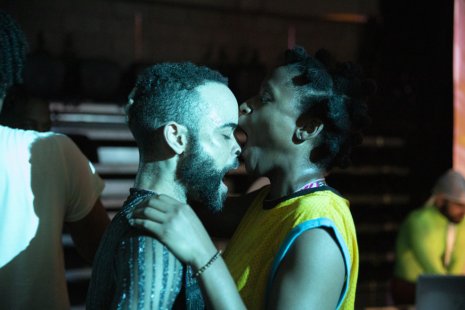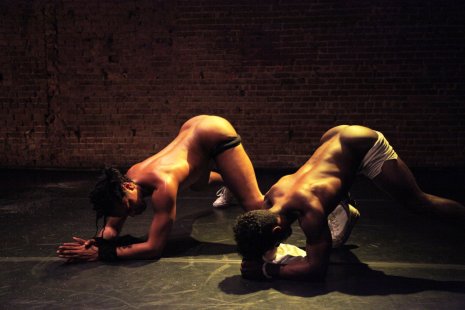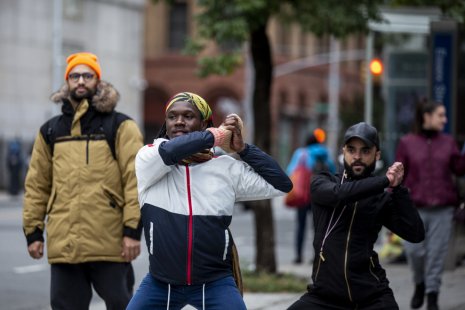In Makini and Donte's Words...
Makini: let’s start with some information about what this work is, right?
Donte: WELL, YOU KNOW I LIKE THE WAY THAT YOU SUMMARIZE IT, SO...
to start, Donte and i have been working on a body of performance and visual works called Let ‘im Move You. the series focuses our investigations into Black majorette performance and culture and allows us to interrogate and agitate the practices of teamwork, social hierarchy, exactitude, rhythm in all of its math-iness, intimacy, sensuality, eroticism, and care.
AND IT’S MAJORETTE, BUT MAKE SURE YOU SPECIFY THAT WE ARE SPECIFICALLY LOOKING AT THE SOUTH...
...and Black folks in the south...
...AND BLACK FOLKS IN THE SOUTH. AND SPECIFICALLY, THE J-SETTE STYLE. SO, GO ‘HEAD AND GIVE YOUR LITTLE J-SETTE EXPLANATION.
[laughter]
my elevator pitch, yes. j-sette, a name that references the majorette line from Jackson State University, the Prancing J-Settes... jackson state majorettes [holds up hands in front of shoulders, and then brings hands closer together] j-s-ettes. so, at the beginning of the 70s, they became known for putting down their batons, and starting to do bigger, more ostentatious choreographies, quoting Black popular culture movement practiced in social settings, and performing alongside the Black pop culture music that the marching bands would play. they would do these call-and-response choreographies — captain leading her squad members — in the stadium seating areas, and had a huge following. and this practice also picked up among many other southern hbcu’s, and their majorette lines, each developing their own style, though the title of j-sette kind of stuck as an umbrella category.
AND OF COURSE, WE HAD THE GAY TEAMS, WHERE WE WERE NOT ALLOWED TO BE MAJORETTES, SO WE FORMED OUR OWN TEAMS. AND FOUND OUR OWN PLACES TO PRACTICE.
and remember that’s where i first found out about that side of j-sette, coming across your videos on youtube like 12 years ago, doing full-bodied choreographies in the space between your bed and the dresser in your bedroom. [laughter] and not hitting a thing.
AND NOT HITTING A THING. THE GIRLS HAVE TO BE PRECISE.
yes, that exactitude. i was so interested in that. and also interested in how many mental tasks we could put on top of it to mess with it...like, how many things we can pay attention to at once.
RIGHT, BECAUSE ATTENTION IS ALREADY SUCH A BIG PART OF J-SETTE. YOUR SPACE IS SPECIFIC, WHETHER YOU ARE ONE OF THE GIRLS IN THE STADIUM, OR IF YOU ARE WITH THE GAYS PERFORMING IN THE CLUBS OR PRIDE EVENTS, WITH PEOPLE ALL AROUND YOU — DRUNK OR JUST DISTRACTED — TRYING TO CUT INTO YOUR SPACE.
right, so attention is also a way to protect yourself.
AND THAT’S ONE OF THE THINGS I APPRECIATE ABOUT OUR WORK, THE TIME WE SPEND MAKING SURE THAT WE UNDERSTAND HOW WE, ME AND YOU, OUR COLLABORATORS ARE COMMITTED TO PROTECT ONE ANOTHER. THE WAYS WE CAN, AND THE WAYS THAT WE CAN’T. OVER THE TIME WE’VE BEEN WORKING TOGETHER, OUR CHECK-IN TIME AT THE BEGINNING OF EACH REHEARSAL OR PERFORMANCE OR MEETING HAS BEEN GETTING LONGER AND LONGER.
oh right! it first started with needs and desires check-ins.
YUP, AND THEN WE HAD TO PUT IN “ANYTHING YOU WANT TO SHARE TO FEEL MORE PRESENT.”AND THEN “EXCITEMENTS AND BOUNDARIES” AND “HOW YOU WANT TO BE PROTECTED, HOW YOU ARE WILLING TO PROTECT.”
my goodness, some of those check-ins felt like they were longer than the time we were actually dancing.
THEY MIGHT HAVE BEEN! [laughter] BUT, THAT’S WHY YOU ALWAYS USED TO SAY THAT WE CAN’T GO FASTER THAN THE SPEED IT TAKES TO GET TO KNOW ONE ANOTHER.
heh heh, i do say that. sometimes, i just have to repeat it because i can get impatient, myself.
OR YOU CHECK YOUR EMAIL INBOX
or i see that list of people rushing me via thousands of unread or unanswered emails in my inbox, right. yeah. but, we committed to an ethic of slow, because so much of this project has been about getting-to-know-you.
EVEN WITH THE WAY THAT WE BRING IN THE WITNESSES.
in Formation [the most recent performance work in the Let ‘im Move You series], we have a whole ritual of bringing the witness participants into the performance space, in small groups, and really introducing them to the space, to each of us performers, and to the terms under which we are inviting them to share space and time with us.
YOU NEED TO TALK ABOUT THE DIFFERENT SPACES WE PERFORM.
our performances have centered around three genres of space: the institutional art space (black boxes, white boxes, etc); sidewalk and alleyway spaces in predominantly and/or historically Black neighborhoods; and party spaces, either as stealth pop-up performances, or our Queer Slow Jam party.
AND WE HAVE TO THINK ABOUT HOW EACH OF THOSE SPACES IS GOING TO VIBE WITH WHAT WE ARE DOING AS BLACK QUEER FOLX.
or not...
OR NOT, AND THEN WHAT DO WE DO WHEN THERE IS CONFLICT, OR IF SOMEBODY REFUSES TO PARTICIPATE OR SOMETHING.
the conflict has been a significant one. there is always the threat of conflict, especially on the sidewalks. it is one of the reasons i try to keep reminding us to look for our support.
BECAUSE IT’S EVERYWHERE.
because it’s everywhere. just like if we look for our detractors, we’ll find them everywhere.
THAT’S ONE OF THE REASONS WHY WE STARTED WORKING WITH MORE ORGANIZERS AND DE-ESCALATORS AND THINGS, TO BE BETTER AT SHARING SPACE TOGETHER, FIGURING OUT HOW TO DO THAT RESPECTFULLY, GRACEFULLY...
...it is always risky. especially because our work gets so complex.
AND INTIMATE.
right, and people need to feel empowered to go to those sexy places together — in public settings, and have the tools to invite what they are excited for, and have stable boundaries to keep out what they do not want. but, i feel like those boundaries even relate to what people can handle mentally and emotionally in relationship to the psychological work of the performances... the ability to find engagement in and rest from all the incessant multitasking.
THERE IS A LOT OF NEGOTIATION WORK INVOLVED.
that feels like a good word for it, negotiation.
THAT EVEN APPLIES TO HOW WE TRY TO MAKE EVERYTHING SO TRANSPARENT WITH THE COLLABORATORS. AND KEEP AS MUCH AS POSSIBLE A CONVERSATION THAT WE ARE ALL INVOLVED IN. FROM THE MONEY DECISIONS TO THE TOUR PLANNING TO THE CONTENTS OF THE SHOWS.
i think that has mostly been true. i want us to be even better with that. with our local collaborators, even though we have worked so hard to have a good amount of time with them, i am not sure how deeply they know the extent to which all of our choices are rooted in what we observe from within j-sette form and culture. like, how the call-and-response form of j-sette turns into all these interrogations of leadership, and how the position of “leader” can be passed around a group, and how the gravity of a formation shifts when the hierarchies shift. or how the emphasis on attention in traditional j-sette has turned into this ridiculously multitasked universe that we created for Formation. how the structures of canon and repetition have invited us to use repetition to turn traditional 8- count structures into nontraditional 10, 11, and 13-count structures in the musical looping and in the choreography.
ALSO HOW RELATED TO THE EXPERIENCE OF BEING AT A CLUB OR PRIDE EVENT THE SHOWS ARE. LIKE, YOU NEVER KNOW WHAT IS GOING TO COME AROUND THE CORNER AT A PARADE, OR WHICH SONG THE DJ WILL SPIN NEXT AT THE CLUB AND HOW THAT IS GOING TO AFFECT EVERYBODY. IT’S LIKE, ESPECIALLY IN FORMATION, THERE IS SO MUCH GOING ON IN THE PERFORMANCE SPACE THAT IT IS HARD TO TAKE ANY SMALL PIECE OF IT AND REALLY REPRESENT THE EXPERIENCE.
where do you think it goes from here?
WELL, WE SAY ALL THE TIME THAT ONE OF OUR BIGGEST DISAPPOINTMENTS FROM THE PANDEMIC WAS NOT GETTING THE TOUR TO GO SOUTH.
right, because the presenters we had conversations going with were not able to afford it anymore.
SO, NOW THAT THE LOCKDOWNS ARE A LITTLE BEHIND US, I AM EXCITED TO FIGURE OUT HOW TO GET SOME OF THIS WORK INTO THE SOUTH.
especially now that i am living in the south [Durham, NC]
UH, RIGHT, NOW THAT YOU ARE IN THE NORTHERN SOUTH
[laughter]
you shady.
BUT, WE HAVE ALSO BEEN TALKING ABOUT DOING ONE FINAL TOUR — IN THE SOUTH — AND WEAVING THAT INTO OUR IDEA TO DO A DOCUMENTARY ON THIS BODY OF WORK
right, we are even working with a producer, so it may happen
IT WILL HAPPEN
it will. i’m excited to have more Queer Slow Jam parties. to keep inviting people into places of tender embraces and that combined hip sway that references that deep sway so important to j-sette.
AND WORKING WITH MORE MULTIGENERATIONAL GROUPS OF PEOPLE.
that has been so important for this work. fully addressing sexuality with young people in the space with us.
AND ONE THING WE BOTH ALWAYS THINK ABOUT IS HOW IT IS IMPORTANT TO MAKE THIS WORK AVAILABLE TO THE YOUNGER VERSIONS OF OURSELVES, WHO NEED TO SEE THIS WORK, NEED TO BE A PART OF IT.
that’s important.
YES, WE HAD AT ONE POINT PLANNED TO END THIS SERIES AT THE END OF OUR TOUR IN 2021. BUT, THIS WORK HAS SOME MORE LIVING TO DO.
and i want to make sure that the presenter partners we work with are really ready to commit to the slow work that we are engaged in, the getting-to-know-you.
RIGHT, THEY HAVE TO BE READY FOR WHAT COMES UP WHEN THIS WORK GOES OUT INTO THE WORLD, ESPECIALLY ON SIDEWALKS.
and support making conversations really full, especially with the Black folx and the Indigenous Native folks that have been in these spaces. it is a super expensive investment to commit to slow within capitalism, and it is only really possible in togetherness.







